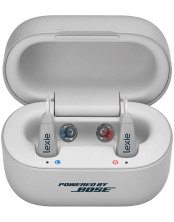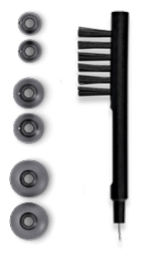How to Read an Audiogram
Published: December 7, 2021
Updated: July 19, 2022
An audiogram is a chart that helps you understand your ability to hear and gauges the extent of your hearing loss. After you’ve taken a hearing test, your audiologist will provide a visual chart of your hearing test results—most commonly referred to as an audiogram. Reading an audiogram is crucial to understanding where your hearing is at and what your results mean, as well as being able to have a conversation with your audiologist to answer any questions you might have.
How is an audiogram measured?
Before the level of your hearing loss can be measured, your hearing threshold must be determined. A hearing threshold is the lowest level sound that can be heard 50% of the time. The audiogram determines this threshold by measuring the softest sounds you can hear at different frequencies (the numbers at the top of the chart) and level of sound (the numbers on the left side of the chart).
Frequency is measured in hertz (hz), which usually ranges from 125 hz to 8000 hz on the audiogram. As the number gets higher, so does the pitch of the sound. A low frequency sound might be something like thunder or a tuba, whereas a high frequency sound might include birds chirping or the sound of a whistle. On the other hand, the level of sound is measured in decibels (dB), which generally ranges from -10 dB to 110 dB on your audiogram. As the number gets higher, so does the level of noise. A low decibel sound might include leaves rustling or whispering, whereas a high decibel sound might include gunfire or a jackhammer. The hearing threshold for normal hearing is usually 0-180 dB and 20-20,000 hz.
Reading an audiogram
While reading an audiogram might seem daunting, it’s quite easy once you understand what each aspect of the chart stands for. Since your hearing might be different in each ear, your left ear’s hearing thresholds are denoted by X’s and your right ear is denoted by O’s on the audiogram. As your hearing is tested at different frequencies, the sounds that you can hear are charted. The placements depend on what decibel (the numbers on the left side) you can hear and is also placed at what frequency the sound occurred. When reading an audiogram, you can see how loud sounds have to be for you to hear them from where the O’s and X’s are marked. If bone conduction also needs to be measured, this will be denoted with a “>” marking for the left ear and a “<” marking for the right ear. This is when sounds are sent to the inner ear through a metal band placed against the bone behind your ear.
By testing what you can hear at different sounds and frequencies, your audiologist will ascertain what you can and cannot hear by reading the audiogram results. See below to understand what the minimum dB of what you can hear means:
-10-20: Normal hearing
20-40: Mild hearing loss
40-70: Moderate hearing loss
70-90: Severe hearing loss
90-120: Profound hearing loss
How Does an Audiogram Help?
Reading an audiogram is very helpful when it comes to moving forward after the severity of your hearing loss has been determined. This is important as it will help you and your audiologist know how to set your hearing aids properly. This means that instead of adjusting all sounds to come in louder, it would be adjusted depending on the chart placements. For example, if you heard normally at 250 hz but had a harder time hearing something at 2000 hz, the decibel would be adjusted so you would be able to hear sounds at that level normally again.
Audiograms will often also include a section called word recognition score (WRS). This is separate from the chart results, where your speech comprehension abilities are measured. This tests your ability to understand language by repeating words your audiologist tells you to. The number of words you get correct is scored out of the words given to calculate your WRS. Usually, a score above 85% is considered normal.
Test Your Hearing with Lexie
Consulting with an audiologist and reading an audiogram can be a helpful way to understand your hearing loss, but there are other methods available as well. One way is by completing a hearing test online, such as Lexie’s free online hearing test. This certified test can provide you with results in minutes and is a great way to determine your level of hearing loss in the comfort of your home.
For more information on Lexie’s hearing test and hearing solutions, visit our website or contact us today.






